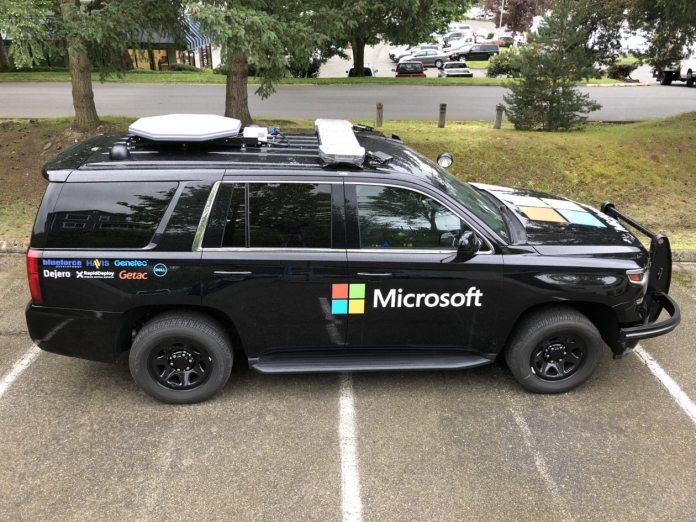[02:09] “I just heard back from our PR team and apparently it is not true, it is a rumor that we [Microsoft] are buying MicroVision. That’s all I have at the moment. Sorry- probably disappointing to a lot of you. No truth to the rumor. We don’t have anything to add at the moment.” The story published yesterday by Florida Independent seems to be based on a story published on TodaysFive from May 8th, 2020. [12.05.2020 – 18:10 CET] Microsoft is reportedly purchasing MicroVision, a leading name in ultra-miniature sensing and projection. According to Florida Independent, Microsoft is acquiring the company to further push into the automotive market. MicroVision uses laser beam scanning and has developed numerous patents related to the technology. Microsoft has already worked directly with the company by using the MicroVision MEMS engine in its HoloLens 2 device. Florida Independent suggests Microsoft will announce the acquisition today. It is worth noting MicroVision is based in Redmond, which is where Microsoft is also headquartered. It seems likely Microsoft will fold the company into its all operations. While Microsoft has worked with the company before, the acquisition could be focused on MicroVision’s wider IP. For example, the company is working with major car manufacturers to provide laser sensor solutions for autonomous vehicle technology.
About MicroVision
MicroVision develops laser scanning technology for projection, 3D sensing, and image capture. MicroVision’s display technology uses a micro-electrical mechanical systems (MEMS) scanning mirror with lasers, optics and electronics to project and/or capture images. The company licenses its products primarily to original equipment manufacturers (OEMs) such as Sony Corporation and STMicroelectronics. MicroVision is the creator of the PicoP scanning technology, an ultra-miniature sensing and projection solution based on the laser beam scanning methodology pioneered by the company. MicroVision’s platform approach for this sensing and display solution means that its technology can be adapted to a wide array of applications and form factors.
In-Car Expansion
Microsoft has been seeking paths to break into the in-car technology market. In September 2019, Microsoft announced the Connected Vehicle Platform (MCVP). The platform is described as an evolving system that automotive companies can use to implement several services into their vehicles:
In-vehicle experiences Autonomous driving Advanced navigation Customer engagement and insights Telematics and prediction services Connectivity and over the air updates (OTA)
In the MCVP-whitepaper from 2019, Microsoft shared its vision for connected vehicles: “MCVP offers the consistent technology infrastructure and support to integrate vehicle assets and solutions, via secure, scalable data ingestion into a common data lake. From there, automakers and partners can use vehicle telemetry to create customized, breakthrough, consumer value added invehicle and cloud services – including telematics, navigation, productivity services, and much more. Furthermore, the capabilities of MCVP extend beyond passenger vehicles to include commercial and industrial vehicles – from cars and trucks, to cranes, ships, and drones. MCVP provides IoT for things that move.” Across the categories, Microsoft is offering 40 Azure-powered cloud services that have been tailored for vehicles. Microsoft’s plans for a concerted effort in the automotive realm stretch back as far as 2017. At CES that year, the company detailed its plans to leverage Azure to create a connected car environment.
It is worth noting, MCVP is not an operating system but rather the underpinning of platforms created by OEM partners. It provides a complete cloud-based back-end for partners to build on. However, it will allow Microsoft to seamlessly integrate services like Skype, Office 365, and Dynamics into in-car systems. Earlier this year, Tara Prakriya General Manager, Azure Mobility, Microsoft Connected Vehicle Platform and Azure Maps, highlighted the growth of MCVP. The platform has already been adopted by companies such as TomTom, LG, and Volkswagen. Prakriya explained how Microsoft wants to become a player in the in-car infotainment space by focusing on innovation: “We are incredibly excited to be a part of the connected vehicle space. With MCVP, our ecosystem partners and our partnerships with leading automotive players, both vehicle OEMs and automotive technology suppliers, we believe we have a uniquely capable offering enabling at global scale the next wave of innovation in the automotive industry as well as related verticals such as smart cities, smart infrastructure, insurance, transportation, and beyond.”
Ericsson Partnership
In December, Ericsson and Microsoft entered a cloud partnership. Azure has become the underpinning of Ericsson’s Connected Vehicles Cloud. Under the terms of the agreement, the communications giant will adopt Microsoft Azure cloud services in its Connected Vehicle Cloud platform. Connected Vehicle Cloud is one of the most popular platforms for in-car connected systems in the world. It is available in more than 130 countries and in over 4 million vehicles. Ericsson says the system will now function on top of Microsoft’s Azure-powered Connected Vehicle Platform. Peggy Johnson, Executive Vice President, Business Development at Microsoft said at the time: “Together with Ericsson, we intend to simplify the development of connected vehicle services to help car makers focus on their customers’ needs and accelerate the delivery of unique, tailor-made driving experiences.”




